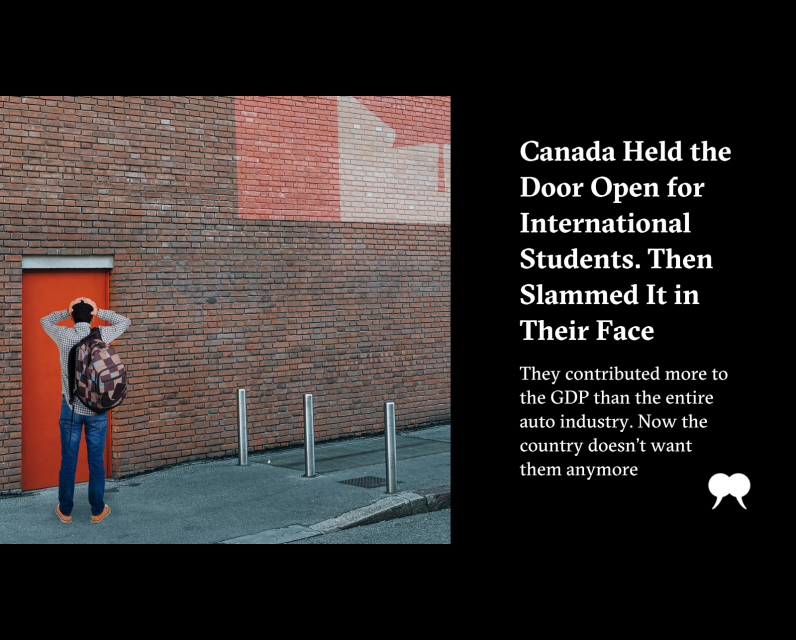Canada Held the Door Open for International Students. Then Slammed It in Their Face

This article contains discussions of suicide. If you or someone you know is having a suicide crisis, please call Suicide Crisis Helpline (9-8-8). There is also the Hope for Wellness Helpline for Indigenous people across Canada (1-855-242-3310).
“Being a queer, non-binary person in India is not the easiest,” Adi Khaitan told me. “The place I grew up was very, very conservative.” Khaitan’s memory of their childhood is “a little bit foggy,” and they declined to share many details about their life in India, only that they were an only child and something happened that resulted in their being diagnosed with post-traumatic stress disorder.
After graduating from high school, Khaitan started to apply to universities overseas. Of the thirty North American schools that sent them acceptance letters, twenty-eight were from the United States and two from Canada: Lakehead University and Memorial University of Newfoundland. Khaitan decided that the political situation in the US didn’t suit them and accepted the offer from MUN. Their parents didn’t even know Khaitan was applying for universities abroad but agreed to pay for their tuition if they covered all their other expenses.
An impulse toward social justice issues was always a part of Khaitan’s psyche, even as a child in India. This intensified once they came out as non-binary after arriving in Canada. “I struggled a lot,” they said. “I’ve gotten death threats from where I’m from.” They have had to close their social media accounts. “It gets scary,” they said. “Now I’m more used to ad hominem attacks, but I wasn’t used to it earlier.” They were also moved to activism by the pressures and precarity they and other migrant students face at MUN. “That’s when I got into migrant organizing,” they said, “both for my personal struggles and constantly hearing about the lack of equity and social justice that exists.”
I met Khaitan in a St. John’s coffee shop filled with MUN students in March 2022. They were an organizer with the Migrant Action Centre. A few days earlier, they and other activists had rallied in downtown St. John’s for migrant students’ rights. Khaitan recognized the oppression inherent in Canada’s migrant worker and migrant student frameworks. And they were angry.
The global migrant student economy is massive and growing ever larger. According to the United Nations Educational, Scientific, and Cultural Organization (UNESCO), the number of international students worldwide more than tripled between 2000 and 2022, from 2 million to 6.4 million. North America and Western Europe host about half of these students, and Canada has long been a major player in the international student marketplace. As far back as 1970, 5 percent of all post-secondary students in Canada, about 15,000 that year, came from abroad. In the 2022/23 school year, international students made up more than a fifth of Canada’s student population.
Until the mid-1970s, migrant students could apply for immigration status during their studies. This changed with the Immigration Act of 1976, which designated international students as temporary visitors. The act barred students from switching schools or programs of study—reminiscent of how the Temporary Foreign Worker Program shackles migrant workers to a single employer. Students were also not permitted to work or apply for immigration while in Canada.
International students began paying more for tuition than their Canadian classmates starting in the late 1970s and early 1980s, even though campus student groups called the measure racist and discriminatory. Some members of Parliament also objected. Still, the premium tuition fees for foreign students stuck.
Canadians figured those students could afford it. The public perception of international students had changed since the 1950s and 1960s, when migrant students were seen as impoverished foreigners who needed the kind of benevolent care Canadians could provide. By the 1970s, though, Canadians started to view international students as privileged citizens of the countries they hailed from. They were the children of high-status parents. Instead of desperate charity cases, these students were potential customers of a Canadian education. Their presence in our schools wasn’t as much a benefit to their curious minds as it was a benefit to our economy.
The financial contributions of migrant students became all the more important during the 1990s, when provincial governments across Canada slashed post-secondary education budgets. International students were seen as the solution to the problem of diminished public funding. Institutions started actively recruiting students from abroad. The feds joined the cause when they introduced the Post-Graduate Work Permit—first as a pilot program on the Prairies and in Atlantic Canada in 2003, then nationally in 2008. Instead of having to leave Canada after graduation, it allowed full-time international students to apply for an open work permit to stay and work in Canada for between eight months and three years, depending on the duration of the grad’s program of study. The PGWPs were meant to lure international students to Canada and fold them into our skilled workforce once they’d completed their studies.
The strategy worked. Enrolment by migrant students in Canadian institutions swelled in the years that followed. Nearly 18,000 international graduates received a PGWP in 2008. By 2015, the number of international students in Canada rose 92 percent, increasing from about 184,000 to nearly 354,000. Canada processed more than a million migrant student visa applications and extensions in 2023, a record, up from 838,000 the year before and 560,000 in 2021. More than half came from India and China, which sent about 427,000 and 101,000 students respectively. Canada now ranks as the third most popular destination for international students worldwide. Only the United States and the United Kingdom host more. These days, about one out of every ten students studying away from home sits at a Canadian desk.
International education supports more than 200,000 Canadian jobs, but their most important contribution is cash. In 2022, international students, including their visiting families and friends, added nearly $31 billion to the country’s gross domestic product, more than double the contribution of Canada’s automotive industry. In 2020, the pandemic-triggered drop in international student enrolment resulted in a $7 billion hit to the Canadian economy.
International students and their families effectively covered the entire budget increase of Canadian post-secondary institutions.
This money is vital for the schools themselves, especially as government operating grants continue to diminish. Between the 2008/09 and 2021/22 academic years, the amount of income from tuition fees at Canadian post-secondary institutions nearly doubled, rising from $9.4 billion to $18.7 billion. But revenue from domestic tuition increased only by 23 percent, while international tuition exploded 471 percent, to $7.1 billion. Tellingly, this sum matches nearly exactly the rise in operating expenses over the same thirteen years: $6.9 billion. In other words, international students and their families back home effectively covered the entire budget increase of Canadian post-secondary institutions. Government funding, on the other hand, barely budged.
Migrant students pick up the government’s slack with their premium-priced fees. On average, international students pay more than five times what their Canadian classmates pay in annual tuition: $38,000 versus $7,100 during the 2023/24 academic year for undergrads. And the gap creeps wider each year. In 2006, migrant undergraduate students paid 204 percent more than Canadian students. In 2023, they paid about 535 percent more.
What makes Canada such an attractive destination for international students isn’t necessarily what students learn at those desks but the opportunities that come afterward. According to a 2024 survey of 100 conducted by the International Organization for Migration, Canada ranks as one of only 13 percent of nations that allow migrant students to work after graduation. Studies by the Canadian Bureau of International Education show nearly a third of international students mention the potential to receive a PGWP as a reason they chose to study in Canada, and 70 percent of international students planned on applying for a PGWP.
But migrant students don’t simply want to work in Canada. Like Khaitan, they want to stay. For international students, permanent residency is more than just a dream or a casual ambition. They don’t suddenly come up with the idea that they might want to stay in Canada after their first Frosh Week keg party. Permanent residency was always the plan: get a student visa, complete a course of study, obtain a PGWP, amass some work experience, then apply for PR. Students don’t just want to stay. They expect to.
And why wouldn’t they? Transitioning international students to permanent residency has long been the government’s overt mission. One of the primary goals of Canada’s 2014 to 2019 International Education Strategy, introduced by the Stephen Harper Conservatives, was to increase the number of international students choosing to remain in Canada after graduation. The strategy explicitly stated that migrant students “are a future source of skilled labour, as they may be eligible after graduation for permanent residency through immigration programs,” and that “students are well positioned to immigrate to Canada as they have typically obtained Canadian credentials, are proficient in at least one official language, and often have relevant Canadian work experience.”
A change in government didn’t change this strategy. Justin Trudeau’s Liberal government echoed the Conservative message when it took over the file in 2015. The 2019 to 2024 strategy, which the Liberals unambiguously titled “Building on Success,” reiterated that international students make excellent candidates for PR, as people who “can help address this country’s current and pending labour market needs.” The plan also recognized that PR pathways for students are one of the “attributes that make Canada a powerhouse in international education.”
These strategies, embraced in turn by both governing parties, resulted in huge numbers of international students transitioning to PR. In 2016, two years before Immigration, Refugees and Citizenship Canada (IRCC) produced a video for potential migrant students with the slogan “Study, explore, work, and stay,” nearly 30,000 former students became permanent residents. More than 157,000 students transitioned to PR in 2021, a record, and nearly 95,000 migrant students obtained PR in 2022. Canada doesn’t want these grads to leave.
I found it profoundly disingenuous, then, when Marc Miller, the immigration minister at the time, said in July 2024 that post-secondary education for international students “can’t be a backdoor entry into becoming a Canadian citizen.” The comment suggests an infiltration when, in fact, the entire international student structure was designed to propel students to permanency. Migrant students had never snuck into Canada through the back door. The front door had been held open for them, by Conservatives and Liberals alike, for at least a decade.
To cross the PR finish line and finally overcome that temporariness, international students must first navigate a labyrinth of scams, exploitation, and often poverty. Some don’t make it out alive.
I reached out to Jaspreet Singh, president of the International Sikh Students Association. Singh arrived in Canada as a student in 2015 and completed a three-year program of study at Sheridan College in Brampton. More than half of Sheridan’s student body were migrants, and at least half of these were Punjabi Sikhs. During his second year, Singh helped start a club for Sikh students.
Soon the students grew comfortable enough to share their problems with other members. Some complained of depression and anxiety. Others had been victims of assault and were dealing with the resulting trauma. Many students also struggled with their academic expectations and the stresses of being an international student. Their problems varied in severity. Some simply needed a friend to speak to while others needed professional therapy.
Despite the club’s best efforts, tragedy can’t always be averted. Singh knows of a student who failed a course but couldn’t afford the retake fee. His college wouldn’t issue him an enrolment letter without this course, so he lost his study permit. This rendered him without status and his presence in Canada illegal. The young man ended up living in a Scarborough park for a while before a family friend took him to Brampton. The friend tried to find him a job, “but he was broken inside,” Singh said. The man went to downtown Toronto and jumped off a bridge in front of a train. “There are many, many cases like this,” Singh said. “Someone who came here at the age of eighteen or nineteen for a better future, for better education, and ended up giving their [life] because the system is exploiting them.”
Kamal Bhardwaj deals with their bodies. Bhardwaj is the president and owner of Lotus Funeral and Cremation Centre in Etobicoke, Ontario. Lotus handles the international students’ funerals and repatriates their remains back to their families in India. Between 2018 and 2021, Lotus repatriated the bodies of about a dozen people per year. In 2022, it sent back thirty-three. When I spoke to Bhardwaj in the fall of 2024, he told me Lotus was repatriating about five bodies back every month—sometimes as many as seven or eight. “The fact is the numbers are increasing,” Bhardwaj said.
While Bhardwaj never sees coroner’s reports and doesn’t know official causes of death, many of these bodies show obvious signs of suicide. Ligature marks on the neck. Crushed bones from a fatal jump. “We just had another jumper last week,” Bhardwaj told me. “Thirty storeys. That body is going to be . . . you know.” Some go to sleep and never wake up, which Bhardwaj considers a likely sign of intentional drug poisoning, though friends and family will often call these heart attacks.
The reasons for these suicides are no mystery. “These kids are kids,” Bhardwaj said. They are teenagers isolated from their families who, in turn, may have sold their farm to finance their Canadian education. “These kids have a lot of pressure on them. And when their parents call and ask, ‘How’s everything?’ they’re not admitting what’s going on. They get into trouble. A lot of mental anguish, financial anguish, and so forth. And, unfortunately, things do happen to these students. They’re taken advantage of in different ways, through abuses. Ultimately, people take their own lives.”
The pressure on these international students starts back home in India, where education consultants aligned with schools in Canada recruit students looking to study abroad. The agents convince recent high school grads in India that they will receive a quality education at these Canadian institutions. Agents charge in excess of $10,000 for this service and, according to Singh, receive a $2,000 commission from the college for every student they enrol.
In Punjab, India’s agricultural heartland, many families are farmers—hardly the country’s privileged elite. Student families often mortgage their land and property in order to afford tuition after already covering the agency’s fees and the student’s travel expenses. The financial burden can be staggering. “It takes seventy-seven years of labour for the average Indian family to pay for the tuition of one international student in Canada,” Singh told me. I thought I’d misheard him; I hadn’t. For the sake of an education, a job, and PR, these families gamble everything. Everything isn’t always enough. Sometimes family investments can’t cover expenses once their student arrives in Canada.
“It takes seventy-seven years of labour for the average Indian family to pay for the tuition of one international student in Canada.”
Many end up sleeping in overcrowded rooming houses and dank basement apartments—not unlike seasonal agricultural workers. Some can’t even afford this. In 2023, the Migrant Workers Alliance for Change estimated between 4 and 5 percent of migrant students were homeless. That year, a viral TikTok video showed a group of international students helping a Conestoga College student from India who’d been living under a Toronto bridge for four days. In early 2024, the Canadian branch of an international Sikh charity in Brampton received five phone calls every day from migrant students seeking food, clothing, and accommodation.
“When you’re going through that situation, your family has already spent thousands of dollars. You don’t think about justice,” Singh said. “You don’t think about your rights. You just want your immigration.” And once these migrant grads finally receive their permanent residency, they don’t want to look back.
The federal government has made sweeping changes to the international student policies in recent months. Beginning in the fall of 2023, students were required to verify the letters of acceptance they received from Canadian schools with IRCC to ensure that they weren’t fraudulent. That December, Miller announced new students would have to prove they had access to $20,635 for living expenses in addition to travel costs and their first year of tuition—more than double the previous amount of $10,000, which hadn’t changed for nearly twenty years. The government vowed to recalculate this sum every year depending on the prevailing cost of living.
The biggest changes came in 2024. That January, Miller imposed a two-year cap on international student visas. He said the government would approve 360,000 undergraduate permits in 2024, down about a third from the previous year. (In the end, the government adjusted the 2024 target to 485,000 permits.) Miller slashed the number of permits by another 10 percent that September, announcing the new target for 2025 and 2026 would be 437,000. The quota now includes graduate and doctoral students, who’d been exempted from the 2024 cap.
The government’s oft-repeated rationale for these policy changes was to protect students from exploitation by bad actors, another invocation of the “Canada the Good” trope. But this was clearly a political decision brought on by low poll numbers and a dearth of affordable housing. “It would be a mistake to blame international students for the housing crisis,” Miller said, unconvincingly. “But it would also be a mistake to invite them to come to Canada with no support, including how to put a roof over their heads.”
Student groups and migrant organizations recoiled at the idea that international students should shoulder the responsibility for Canada’s housing woes. At MUN, student union representative Jawad Chowdhury told the CBC that instead of reducing the number of migrant students, governments should invest in campus housing or introduce rent control measures—not turn migrant students away.
But Miller wasn’t finished. He went after PGWPs too. First, he announced that international students graduating from public-private colleges, institutions he described as “the diploma equivalent of puppy mills,” would no longer qualify for PGWPs. He framed the decision as a punishment for the institutions. “It’s unacceptable that some private institutions have taken advantage of international students by operating under-resourced campuses, lacking supports for students and charging high tuition fees, all the while significantly increasing their intake of international students,” he said.
Then, Miller announced that in order for students in non-degree programs and public college diploma programs to qualify for PGWPs, they must graduate from a field of study that aligns with labour market needs—namely, agriculture and agri-food, health care, trade and transportation, and STEM. The government provided a list of 966 eligible programs. (International students graduating with university degrees all remain eligible for PGWPs.) Applicants also needed to meet new language-proficiency requirements.
On the surface, these new restrictions look economically responsible. Logical even. The government can point to the new PGWP parameters and claim they’re simply responding to the reality of Canada’s labour shortages. This isn’t education as much as it is job training. But by tightening the PGWP qualifications and placing a roadblock in the middle of the long-established “Study, explore, work, and stay” pathway, the government is blatantly deterring migrants from enrolling in Canadian schools at all. The new caps on study permits combined with the stricter rules for PGWPs form a double disincentive for migrant students. If workers can’t stay, the government seems to be saying, hopefully they won’t come.
And they aren’t. The number of international students on Canadian campuses plummeted in the fall of 2024. The president of Universities Canada told Global News that enrolment of international university students was expected to drop by 45 percent. Canadian colleges anticipated a 54 percent drop. Post-secondary institutions in British Columbia saw foreign enrolment fall in half. In Ontario, Mohawk College saw a near 40 percent drop in migrant enrolment, and only sixty students moved into a newly built 300-bed student residence. Only 775 of the expected 1,600 new migrant students showed up for class at St. Lawrence College in Kingston; about 1,400 migrant students deferred their fall programs to the winter at Conestoga College.
Fewer international students means less premium tuition, of course. The 9 percent decline in foreign enrolment at the University of Calgary, my alma mater, caused an $11 million hit to school revenue. On Vancouver Island, Camosun College’s 400 fewer international students brought on a $5 million shortfall. Ontario’s universities said revenue would drop by a staggering billion dollars in 2024 and 2025 combined.
Schools nationwide had to make cuts as a result. Colleges started laying off staff, delaying infrastructure, and closing campuses. In December, a report by the Financial Accountability Office of Ontario showed the province’s colleges cut spending by $752 million due to the drop in international student enrolment. The policies also impact the communities around the schools. Colleges and Institutes Canada president Pari Johnston worried the limits on PGWPs would harm local businesses that rely on grads for labour.
While the government succeeded in discouraging international students from coming to Canada, it didn’t seem to think about the international students already here. Due to the policy changes and the ineligibility for PGWPs, between 70,000 and 130,000 migrant students would lose their status in two years following the policy change. Some of these students, quickly and predictably, adopted a Plan B to stay in Canada. Nearly 13,000 international students applied for asylum in Canada by September 2024, an increase of about 1,600 from the year before.
I don’t condone fraudulent asylum applications, but I admire the students’ policy hack.
Even if these claims eventually fail, the students–cum–asylum seekers will earn another three years in Canada as their applications are considered—the same length as a PGWP, as it turns out. During this time, they’re eligible for health care, reduced tuition, and work permits. At the very least, they can spend a few years paying back some of their recruitment and tuition debt. I don’t condone fraudulent asylum applications, but I admire the students’ policy hack.
Others will face deportation. The end of their permits likely means the end of their time in Canada. These graduates had expected to stay. They didn’t just dream of a life in Canada; they were offered it. We promised these grads a home. Instead, they became collateral damage.
Adapted and excerpted, with permission, from Precarious: The Lives of Migrant Workers by Marcello Di Cintio, published by Biblioasis, 2025. All rights reserved.
The post Canada Held the Door Open for International Students. Then Slammed It in Their Face first appeared on The Walrus.



Comments
Be the first to comment